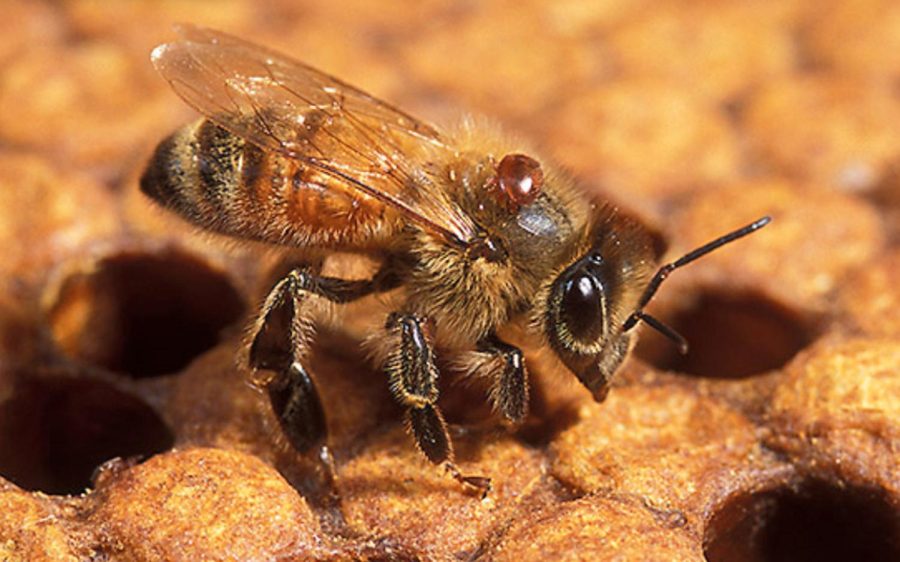Honeybees, consumers face threat from mite-fighting pesticides
Suspect pleads guilty to smuggling illegal chemicals
July 11, 2022
Smuggling operations along the U.S./Mexico border typically deal with illicit drugs, illegal weapons and human trafficking, but a recent takedown is noteworthy for its more unusual targets — pesticides and honeybees, an integral part of the food supply.
What was smuggled was an illegal pesticide used to kill Varroa mites on the honeybees.
The United States Department of Agriculture states the mites are “a major threat to honey bee health and are becoming resistant” to the chemical compounds used to control them.
At the same time, Professor James C. Nieh, associate dean of UC San Diego’s Department of Ecology, Behavior and Evolution, warns that the smuggling of the concentrated pesticide chemical amitraz “poses a major risk for honeybees.”
Sofia Mancera Morales was the ringleader of a pesticide smuggling organization, according to the U.S. Attorney’s Office in San Diego. She admitted to obtaining pesticides in Mexico and directing her smuggling ring to bring the chemicals into the United States.
The pesticides were mainly Bovitraz and Taktic, which contain amitraz in a higher concentration than is permitted.The chemical kills the mites, but it also “could cause neurological effects and reproductive effects in humans from consumption of contaminated honey.”
That’s according to Assistant U.S. Attorney Melanie Pierson, who oversaw the prosecution and has been the lead on other cases involving pesticide smuggling across our shared border, as previously reported by the Times of San Diego.
Pierson was joined in a multi-task force effort by the EPA Criminal Division and Homeland Security Investigations. Also participating was Special Assistant U.S. Attorney Stephen DaPonte.
“In exchange for ill-begotten profits, this cavalier smuggling operation was more than willing to risk the public’s health and the honeybee industry, which is critical to pollinating our food supply,” San Diego U.S. Attorney Randy Grossman said after Morales pleaded guilty.
Morales received eight months in custody followed by two years of supervised release and has to pay restitution of $7,497 to dispose of the illegal pesticides.
In animal studies, amitraz reduces male fertility and live births. It is also classified as a “possible human carcinogen based on rodent studies suggesting that long-term exposure could result in cancer,” the court documents state.
The chemicals were being smuggled into the country beginning in January 2020. Morales told her co-conspirators to bring the pesticides over the border to StaxUp Storage in Calexico, the U.S. Attorney’s office stated.
The smugglers were to send Morales images of the pesticides at the storage unit as proof of delivery before providing payment for the smuggling. Other co-conspirators would then “pick up the pesticides from the storage unit and further distribute them in the United States, by sale, shipment or delivery,” according to the criminal case filing.
The filing goes on to state that Morales knew the pesticides were illegal in the United States and not available for sale and would be seized if discovered. The smugglers were to tell inspectors that the bottles of unregistered pesticides were for dog shampoo for fleas and ticks. There is a shred of truth in this, it turns out. The smuggled pesticides, at far lower levels of potency, are used in dog collars for flea control, such as Preventic brand.
Morales recruited her team on Facebook, offering to pay up to $150 “for each box of six 1-liter bottles,” according to the court filing. One smuggler admitted to U.S. authorities that he “brought two to three boxes of pesticides into the United States on three prior occasions and delivered them to the same storage unit at StaxUp self-storage in Calexico, for which he was paid $100-$150/box.” The smuggler had cell photos of the chemicals in the Calmexico storage locker.
The filing goes on to state that another recruit delivered almost 1,000 bottles of pesticides in 30 days, while others were dropping off the pesticides at the storage unit two to five times a week.
What drove the underground operation is a growing demand to combat the threat of the Varroa mites. According to the USDA, mites are considered “public enemy number one” to honeybees nationwide.
“Every honey bee colony in the United States and Canada either has Varroa mites today or will have them within several months,” the Honey Bee Health Coalition warns on a page dedicated to resources about the pest.
The parasite feeds on the blood of bees, “endangering the entire hive when infestations become severe,” the USDA states. The mites also pose an indirect threat to more than 90 flowering crops that depend on bee pollination, such as apples, blueberries, cherries and cantaloupes.
But what is being used by some to kill the mites is potentially dangerous to humans and the hives, as Pierson detailed in her court filing.
UCSD’s Nieh said that up to a third of honeybee colonies in the United States “die during the winter, and a major cause of death is infestations by Varroa mites” every year.
Nieh said that while amitraz is one of the chemicals used to control the infestations — at concentrations of 3.33% in licensed products — “the smuggled solutions contained amitraz concentrations that were nearly four times that, at 12.5 percent.”
The Carl Hayden Research Center in Tucson, Arizona, is researching how the mites piggyback on foraging bees who enter hives and what can be done to address the problem.
J.W. August is a longtime San Diego broadcast and digital journalist.
encinitas current, cardiff current





